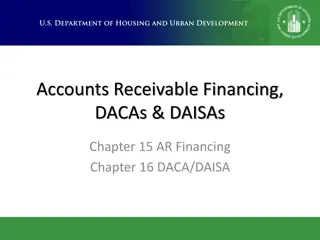Exploring Small Business Financing Options
This presentation discusses various financing options for small businesses at different stages of operation, covering topics such as the U.S. Small Business Administration, business financing stages, starting a business, lending requirements, business plan essentials, traditional and non-traditional financing, and key considerations for entrepreneurs. The emphasis is on guiding businesses towards financing success and highlighting the role of the SBA in supporting small business owners.
Download Presentation

Please find below an Image/Link to download the presentation.
The content on the website is provided AS IS for your information and personal use only. It may not be sold, licensed, or shared on other websites without obtaining consent from the author. Download presentation by click this link. If you encounter any issues during the download, it is possible that the publisher has removed the file from their server.
E N D
Presentation Transcript
Financing Your Small Business Options for Start-up, Growing and Mature Operations Roderick L. Johnson Lender Relations Specialist/SBDC Officer SBA-Washington Metropolitan Area District Office (WMADO)
Disclaimer The following presentation is offered as general guidance only. Any business should confer with its own qualified team of legal and financial advisors before undertaking the risks associated with entrepreneurship, as serious losses may result. 3
Agenda The Path to Financing Success The U.S. Small Business Administration (SBA) Business Financing Stages Starting Your Business Lending Requirements Business Plan Essentials Traditional Financing Bank Loans Non-Traditional Financing Questions to Consider Q&A 4
The U.S. Small Business Administration (Slide 1 of 2) The U.S. Small Business Administration (SBA) was established by Congress on July 30, 1953 to assist and advocate for the small business community. The SBA guarantees loans through approved/preferred lenders. The SBA does not lend money directly, except in instances of declared disasters (Office of Disaster Assistance) 7(a) loan program (working capital, seasonal, builder s & contract) CDC/504 loan program: long-term loan program with fixed rates to encourage economic growth within a specific community. Microloans; maximum loan amount of $50,000 Community Advantage (mission-focused lenders only); maximum loan amount of $250,000 5
The U.S. Small Business Administration (Slide 2 of 2) The business must be located in the U.S. Start-up or existing small business Must have a business plan The SBA guaranty is between 50% and 85%, depending on the loan program; e.g., SBA Veteran Advantage loan is backed at 50%, whereas 7(a) loans are backed at 75% to 85%. SBA-backing may help free up capital for potential borrowers. 6
Business Financing Stages Pre-startups (conceptual/planning phase) Startups < 2 years Undercapitalized firms Growth firms Mature firms The two most common mistakes made by business owners are not properly funding the company at inception and, as the business grows, not paying payroll taxes. 7
Starting Your Business Selecting and creating a business entity: LLC/LLP/C-Corp/S-Corp/Sole Proprietorship Establishing your Employer Identification Number (EIN); see IRS Form SS-4 Securing your business license(s); check with your state or county Completing employee verifications: IRS Form I-9/e-Verify/U.S. Citizen & Immigration Services (USCIS) Purchasing commercial Insurance Applying for set-aside designations and certifications, as applicable 8
The LLC Business Entity (Slide 1 of 9) What Is a Limited Liability Company (LLC)? A Limited Liability Company or LLC is a business structure in which the owners or members have limited liability with respect to the actions of the company. An LLC offers its members the benefit of personal liability protection, meaning that any business liability cannot be recovered from the personal assets of the owners. An LLC is formed and operated under state law. Its characteristics are similar to that of a corporation and a partnership business. Its dissolution, too, is governed by state law. 9
The LLC Business Entity (Slide 2 of 9) Owners as Members The owners of an LLC are called its members. The members can either manage the company themselves or appoint one of the members to manage the day-to-day operations of the company. The members can also choose to appoint a professional manager. Forming an LLC To form an LLC, you must prepare and file articles of organization with the state agency (usually the Secretary of State) where the principal place of business is located. Most states have a standard form to submit articles of organization. Contrary to popular belief, the required paperwork to form and operate an LLC is not similar to that of a corporation; the documents required to establish an LLC are actually minimal. 10
The LLC Business Entity (Slide 3 of 9) The Advantages of a Limited Liability Company You can form a limited liability company with just one member (Single Member LLC). You can include an entire company as a member of an LLC. The owners of an LLC are protected against the business liabilities of the company. The operations of an LLC are headed by the managing members. Since there is no board of directors, there are no requirements for holding regular board meetings. It requires very little bookkeeping; financial and administrative requirements are also simple. 11
The LLC Business Entity (Slide 4 of 9) The Disadvantages of a Limited Liability Company You must pay employment tax on company earnings. An LLC is like a partnership business: you cannot make profits from incentive stock. Since LLCs are governed by state law, different rules apply in different states. Tax treatment also varies with the state. You may have to pay tax in some states, while no tax may apply in others. 12
The LLC Business Entity (Slide 5 of 9) LLC Tax Status Choices The Internal Revenue Service assigns default tax status to a new LLC, unless its members choose an alternative tax status. The IRS automatically taxes an LLC with only one member as a sole proprietorship. An LLC with multiple members is automatically taxed as a partnership. 13
The LLC Business Entity (Slide 6 of 9) LLC Tax Status Choices (continued) The profit of a single-member LLC taxed as a self-employed proprietor is reported on the member s personal federal income tax return (1040). Income tax is calculated at the graduated rates for personal income tax. The LLC profit is subject to the same self- employment tax as a proprietor that did not form an LLC. Therefore, a single-member LLC is referred to as a disregarded entity for federal income tax purposes if the profit is taxed like a proprietorship. 14
The LLC Business Entity (Slide 7 of 9) LLC Tax Status Choices (continued) The profit of an LLC taxed as a partnership is reported on a separate income tax return (Form 1065). However, the income tax is paid when each LLC member reports his or her respective share of profit on their personal income tax return. Income tax at personal rates plus self- employment tax is calculated and paid with the personal income tax return of each member. 15
The LLC Business Entity (Slide 8 of 9) LLC Tax Status Choices (continued) For an LLC taxed as a corporation, profit is reported on a corporation tax return. Tax is calculated at corporate tax rates which are different than personal rates and paid by the corporation. The LLC members are not taxed personally except for wages or dividends they receive from the LLC. 16
The LLC Business Entity (Slide 9 of 9) LLC Tax Status Choices (continued) An LLC taxed as a corporation may elect S corporation status by filing Form 2553 with the IRS. In this case, the LLC files a tax return but doesn t pay income tax on the profit. Instead, members report their portions of profit on their personal income tax returns, just like a partnership. But no self- employment tax is assessed on the profit of an LLC taxed as a corporation. However, there is an assessment of employment taxes on wages paid to a member, just like any employee of a corporation. 17
The LLP Business Entity (Slide 1 of 3) A limited liability partnership (LLP) is an entity that allows its members to take an active role in the business of the partnership without exposing them to personal liability for actions of other partners, except to the extent of their investment in the LLP. In some partnerships, often called general partnerships, individual partners are liable for each other s debts and obligations. An LLP is different because it provides each individual partner protection against personal liability for certain partnership liabilities. 18
The LLP Business Entity (Slide 2 of 3) Advantages of an LLP An LLP limits each partner s personal liability for actions of other partners in the firm. Their liability will be limited to the amount that they contributed to the LLP for its formation. An LLP offers flexible management roles for its partners, which are defined in the LLP agreement. Each partner has the right to manage the LLP and has the right to choose how much management responsibility they want to assume. LLPs are relatively easy to form and require the partners to fill out a registration form and file it with the local secretary of state. 19
The LLP Business Entity (Slide 3 of 3) Disadvantages of an LLP LLPs aren't allowed everywhere because their tax filings can be complex. Some states don't recognize LLPs as a legal entity. In some states, LLPs can be created but not by certain professionals (like doctors). LLPs are often associated with having less credibility than other business structures. This is why many entities choose to incorporate themselves as actual corporations rather than LLPs. In an LLP, individual partners do not have to consult with one another when they are conducting certain activities; in addition, financials must be submitted for public record. 20
The C Corporation Business Entity (Slide 1 of 3) A C corporation is owned by shareholders, who must elect a board of directors that makes business decisions and oversees policies. In most cases, a C corporation is required to report its financial operations to the state attorney general. Because a corporation is treated as an independent entity, a C corporation does not cease to exist when its owners or shareholders change or die. The owners of a C corporation have limited liability. Thus, they do not stand personally liable for debts incurred by the corporation. They cannot be sued individually for corporate wrongdoings. 21
The C Corporation Business Entity (Slide 2 of 3) Advantages of a C Corporation The owner (majority shareholder) of a C corporation has the option of issuing different "classes" of stocks to different shareholders. This helps attract different groups of investors, as common stocks and preferred stocks both have their own distinct advantages that may appeal to one but not another. As opposed to a sole proprietor or an LLC, corporations are usually at a lower risk of being audited by the government. A C corporation can deduct the cost of benefits as a business expense. For example, they can write-off the entire costs of health plans established for employees as business expenses. These benefits are tax-free even for those receiving them. 22
The C Corporation Business Entity (Slide 3 of 3) Disadvantages of a C Corporation The most often-cited disadvantage of using a C corporation (C Corp) is the double-taxation issue. Double-taxation happens when a C Corp has a profit left over at the end of the year and wants to distribute it to the shareholders as a dividend. The C Corp has already paid taxes on that profit, but once it distributes the profit to its shareholders, those shareholders will have to declare the dividends they receive as income on their personal tax returns and, as a result, pay taxes again at their own personal rates. The corporation laws require more formalities in how a corporation is managed. For example, shareholder and director meetings are required. Proper notice must be given and minutes must be kept. Corporation laws also tend to have stricter record-keeping requirements. 23
The S Corporation Business Entity (Slide 1 of 5) With an S corporation, income and losses are passed through to shareholders and included on their individual tax returns. As a result, there's just one level of federal tax to pay. An S corporation can have no more than 75 shareholders and only individuals, estates, certain trusts, certain partnerships, tax-exempt charitable organizations, and other S corporations (but only if the other S corporation is the sole shareholder) can be shareholders. The stock of S corporations is freely transferable. This means the shareholders of S corporations are able to sell their interest without obtaining the approval of the other shareholders. 24
The S Corporation Business Entity (Slide 2 of 5) Advantages of an S Corporation Limited liability for management and shareholders. An unlimited number of management, no state residency requirements. Distinct, court-recognized existence, which helps protect you from personal liability that can cause you to lose your personal wealth in assets like your home, car, or nest egg. Flow-through taxation: Profits are distributed to the shareholders, who are taxed on profits at their personal level. Great income-splitting potential for owner/employees. Can take a smaller salary and pay income taxes and regular payroll deductions, then take the remainder of profit as a distribution subject to income tax only. 25
The S Corporation Business Entity (Slide 3 of 5) Advantages of an S Corporation (continued) S corporations are great for businesses that: will provide a service (i.e. consultants); will not have significant start-up costs; will not need to make major equipment purchases before beginning operations; and will make a sizable amount of money without a great deal of effort and expense. 26
The S Corporation Business Entity (Slide 4 of 5) Disadvantages of an S Corporation At shareholder level, shares are subject to seizure and sale in court proceedings. Maximum of 100 shareholders, all of whom must be U.S. residents or resident aliens. Shares must be held directly, except in special circumstances. Owner/employees holding 2% or more of the company s shares cannot receive tax-free benefits. Because flow-through taxes will be paid at the personal rate, high-income shareholders will pay more taxes on their distributions. 27
The S Corporation Business Entity (Slide 5 of 5) Disadvantages of an S Corporation (continued) Not suitable for estate planning vehicle, as control is ultimately in the hands of the stockholders. In a planned gifting scenario, once majority control passes to children from parents, children can take full control of the company. If tax status is compromised by either non-resident stockholder or stock being placed in corporate entity name, the IRS will revoke status, charge back-taxes for 3 years and impose a further 5-year waiting period to regain tax status. Not suitable to hold appreciating investment. Capital gain on sale of assets will incur higher taxes than with other pass- through entities, such as LLCs and Limited Partnerships. Limited to one class of stock only. 28
The Sole Proprietorship Business Entity (Slide 1 of 5) The simplest and most common structure chosen to start a business. An unincorporated business owned and run by one individual with no distinction between the business and you, the owner. You are entitled to all profits and are responsible for all your business debts, losses and liabilities. 29
The Sole Proprietorship Business Entity (Slide 2 of 5) Forming a Sole Proprietorship You do not have to take any formal action to form a sole proprietorship. As long as you are the only owner, this status automatically comes from your business activities. In fact, you may already own one without knowing it. If you are a freelance writer, for example, you are a sole proprietor. But like all businesses, you need to obtain the necessary licenses and permits. Regulations vary by industry, state and locality. Use the Licensing & Permits tool to find a listing of the federal, state and local permits, licenses and registrations you'll need to run a business. If you choose to operate under a name different than your own, you will most likely have to file a fictitious name (also known as an assumed name, trade name, or DBA name, short for "doing business as"). You must choose an original name; it cannot already be claimed by another business. 30
The Sole Proprietorship Business Entity (Slide 3 of 5) Sole Proprietorship Taxes Because you and your business are one and the same, the business itself is not taxed separately-the sole proprietorship income is your income. You report income and/or losses and expenses with a Schedule C and the standard Form 1040. The bottom-line amount from Schedule C transfers to your personal tax return. It s your responsibility to withhold and pay all income taxes, including self-employment and estimated taxes. You can find more information about sole proprietorship taxes and other forms at IRS.gov. 31
The Sole Proprietorship Business Entity (Slide 4 of 5) Advantages of a Sole Proprietorship Easy and inexpensive to form: A sole proprietorship is the simplest and least expensive business structure to establish. Costs are minimal, with legal costs limited to obtaining the necessary licenses or permits. You have complete control. Because you are the sole owner of the business, you have complete control over all decisions. You aren t required to consult with anyone else when you need to make decisions or want to make changes. Easy tax preparation. Your business is not taxed separately, so it s easy to fulfill the tax reporting requirements for a sole proprietorship. The tax rates are also the lowest of the business structures. 32
The Sole Proprietorship Business Entity (Slide 5 of 5) Disadvantages of a Sole Proprietorship Unlimited personal liability. Because there is no legal separation between you and your business, you can be held personally liable for the debts and obligations of the business. This risk extends to any liabilities incurred as a result of employee actions. Hard to raise money. Sole proprietors often face challenges when trying to raise money. You cannot sell stock in the business, which limits investor opportunity. Banks are also hesitant to lend to a sole proprietorship because of a perceived additional risk when it comes to repayment if the business fails. Heavy burden. The flipside of complete control is the burden and pressure it can impose. You alone are ultimately responsible for the successes and failures of your business. 33
Lending Requirements (Slide 1 of 3) Personal FICO score of 700 > Tangible collateral (cash, marketable securities, residential and commercial real estate) Management expertise If already in business, the business is showing a net profit. The business has retained some net profits in the business. The business is collecting its accounts receivable in 35-40 days. The business is showing year-over-year sales growth. The business has adequate working capital. Both the personal and business tax returns are filed on time. No business or personal taxes are owed to Uncle Sam. 34
Lending Requirements (Slide 2 of 3) Credit worthiness personal and business Cash flow will the company generate enough cash to make the loan payments? Are your cash flow projections realistic? Collateral is there enough collateral to make the lender feel comfortable? Understanding RISK what type of risk are you and your business? Low Moderate High 35
Lending Requirements (Slide 3 of 3) Character Capacity Capital Conditions Demonstrable discipline and commitment to carrying out the operations of the business on a daily basis. Common sense 36
Business Plan Essentials (Slide 1 of 2) A good business plan answers the following questions: What does the business do? How old is the business startup? What are the business goals? What is the future of your business industry? What risks are involved in the operation of your business? What market does your business serve? How will you identify and sell to your potential customers? 37
Business Plan Essentials (Slide 2 of 2) Financial Statements and/or Projections are Key Sales forecast Cash flow projection Income statement (profit and loss) Sources and uses of funds chart Balance sheet Financial planning assumptions Break even analysis Footnotes to the financials 38
Traditional Financing Financing is provided through the commercial banking sector. Commercial banking must comply with all Federal, State and local government regulatory requirements. These entities are governed by the Federal Deposit Insurance Corporation (FDIC). Traditional financing from banks consists of: Time notes Lines of credit Term loans Equipment loans Letters of Credit Asset based loans SBA Guaranteed Loans; i.e., 7(a), 504, Export, Micro and Disaster Loans (Get an SBA Guaranteed Loan through an approved SBA Lender) 39
What is Needed to Get an SBA-Backed Bank Loan Money Talks Ten percent to 20% or more of your own money invested into the total project cost Written business plan FICO score of > 650 Three years of business financial statements (2016, 2017 and 2018) Three years of business tax returns (2016, 2017 and 2018) QuickBooks interim financial statements as of 7/31/19 QuickBooks accounts receivables and accounts payable aging, as of 7/31/19 Financial projections for 3 years showing ability to repay the loan Collateral to cover the loan amount Personal financial statement SBA guarantee 40
Community Development Financial Institutions Several local community banks, credit unions and micro lenders have this designation About 4 in 10 small businesses with less than $1 million in annual revenue were denied financing at small banks, and more than half were rejected at big banks, according to the 2016 Federal Reserve Small Business Credit Survey It can be even harder for underserved or less-formal small business owners to access capital. There may be fewer traditional financial institutions like banks or credit unions in your area, or you may have tried to get financing at those institutions but didn t meet their underwriting or documentation requirements. If either is the case, you might try your luck with financing from community development financial institutions, or CDFIs. Why? The approval rate for sub-$1 million revenue businesses was better than 75%, the Federal Reserve s survey shows. 41
Microloans Usually for businesses that do not have access to traditional financing Usually a slightly higher interest rate Technical assistance requirements More lenient credit requirements Character-based lending $500 to $50,000 Great for start-up businesses Easier to qualify for Unrestricted use of funds Smaller repayment amounts 42
Invoice or Factoring Financing The Assignment of Claims Act of 1940/ Uniform Commercial Code-1 You are using your invoices to access the capital you need by doing business with creditworthy clients (government or business to business). Purchase of business to business or business to government accounts receivable (invoices) for goods that have been delivered or services that have been rendered in the past for a fee. Factoring/Accounts Receivable Funding is not a loan; it is the sale of an asset. This type of arrangement is great for companies under 2 years old. This type of arrangement is great for companies that do not have strong financial statements A strong Dun & Bradstreet or strong personal FICO score is not needed. 43
Alternative Financing (Slide 1 of 7) kiva.org Started in 2005 in San Francisco Kiva is an international non-profit organization Provides microfinancing Has made loans to borrowers in 81 countries 81% of Kiva borrowers are women Funded 3M borrowers with 1.7M lenders Funded $1.19B at a 96.9% repayment rate 44
Alternative Financing (Slide 2 of 7) Bootstrapping Using your own money to start and run your business. These funds can come from any of the following: Personal savings Personal credit cards Home-equity loans The disadvantages of bootstrapping are that it can put limits on your business growth and you might not be able to attract enough funds to get the business up and operating. 45
Alternative Financing (Slide 3 of 7) Family & Friends The advantages and benefits to having family and friends finance your business include fast access to cash, financial statements are generally not required, and little-to-no documentation/paperwork is needed. The disadvantages of relying on family and friends to finance your operations are they may want to run your business; they may want a return of principal plus interest lent to the company before it generates net profits; and, if the business fails, your relationship may be strained or ended forever. 46
Alternative Financing (Slide 4 of 7) Crowdfunding Crowdfunding is where a group of individuals funds your project, idea, book or your business prior to a product or service being delivered. The benefits of crowdfunding is your business is funded quickly and can be done so through multiple funding sites. The biggest advantage is you do not have to repay the funds. The disadvantage of crowdfunding is that you pay a fee to the funding platform. Also, some funding sites require the full project be funded or you risk no payout. Lastly, you must provide something in return for receiving funding (e.g., an ownership stake in the company). 47
Alternative Financing (Slide 5 of 7) Asset-Based Lending Asset-based lending is where you leverage your company s assets to secure working capital. With asset- based lending, you rely on your company s accounts receivables, inventory, equipment and/or real estate to secure the necessary financing. This type of financing is suitable for highly leveraged or under-capitalized firms. The benefit of asset-based lending is it comes in the form of a revolving line of credit and it provides short- term working capital. The disadvantages of asset-based lending include high due diligence fees, encumbered assets and the need to produce strong financial statements. 48
Alternative Financing (Slide 6 of 7) Equity/Vulture Capital This type of financing is a private investment into a qualified business for future growth, expansion or gain. This is not for the startup that is not profitable. The 3 stages of vulture capital are: pre-seed/seed, expansion or mergers and acquisitions. The benefits of vulture capital are it raises capital, creates no debt, management support, and offers limited repayment responsibilities. The disadvantages of vulture capital include high due diligence fees, the need to have a strong management team in place with strong business financials, the company must give up a portion of the equity in their business, and a lengthy process before receiving the equity injection into the firm. 49
Alternative Financing (Slide 7 of 7) Angel Investing This type of financing is a private investment into early stage or start-up businesses for future growth, expansion or gain. Companies like Pinterest, Uber, WhatsApp and Facebook used this type of financing. Angel funding is usually from $25K to $1M and funded in geographic regions with which the angels are already familiar. The benefits of angel investing include receiving advice and counsel from the angel, flexible terms, and potential contacts with other angel investors. Among the disadvantages of using angel investors are that only 1 in 10 startups is successfully funded, along with the lengthy process to get funded. However, the biggest disadvantage is having to give up an ownership stake in your company. 50























